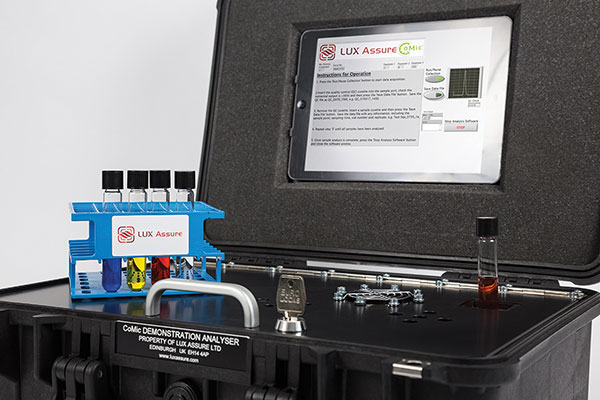October 2018, Vol. 245, No. 10
Features
Asset Integrity Through On-Site Chemical Monitoring
By Emma Perfect, CEO, LUX Assure
Ensuring effective asset integrity management is a growing challenge for many, if not all, operators within the oil and gas industry. The safe and profitable operation of maturing assets is a global concern, and one that has been intensified by the continued focus on cost efficiencies.
Chemical management plays a vital role in asset integrity management but with a plethora of chemicals used to support continuous well production, ensuring the correct dosage for each can be challenging. Too much can lead to production upsets, oil contamination or environmental damage; too little and you face problems such as hydrate build-up, scaling and the nemesis of asset integrity – corrosion. As such, one of the greatest challenges operators face in the asset integrity battle is effectively mitigating internal corrosion.
The importance of adopting new technologies that can both improve production and save on operating costs has been widely recognized with on-site testing methods proving to be highly beneficial with regards to delivering operational and cost efficiencies.
Combating corrosion is a priority in asset integrity management and corrosion inhibitors are the first line of defense against internal corrosion. Up-to-date accurate dosage information is therefore essential, and so the most effective mitigation strategies are ones where the proactive monitoring and management of inhibitors allows for regular feedback and timely dose adjustments to take place.
In the oil and gas sector, chemical corrosion inhibitors are routinely used to protect process equipment and pipeline infrastructure. Establishing optimum dosage levels is difficult, as conditions can change rapidly in the field, with such changes impacting chemical availability and therefore protection.
Where this leads to under-dosing, the risk of corrosion increases, yet adding more inhibitor is not always a solution as surplus chemicals may offer no additional protection, and can cause separation issues, which are time-consuming and expensive to resolve.
A recent survey conducted by Saxon Weber, on behalf of LUX Assure, looked at the management of corrosion inhibitors across the oil and gas industry. It revealed that after cost control and optimization of chemical dosage, real-time monitoring solutions were considered the biggest challenge.
Additionally, more than 37% of respondents said they strongly agreed that improving corrosion inhibitor management could have a significant effect on reducing production upsets, reducing OPEX and improving long term asset integrity.
To address the requirement for improved on-site testing methods, LUX has three technologies – CoMic, OMMICA and TraxBio. CoMic is a corrosion inhibitor detection technology that can be used as part of a comprehensive asset integrity management program.
Developed based on the tendency of many surfactant type corrosion inhibitors to form micelles, CoMic generates data in the field, which complements other corrosion data collected to enhance corrosion inhibitor management and inform operators of the optimal dosage level.
The process is simple – a sample is mixed with a marker and analysed with LUX’s proprietary CoMic instrument. The data produced is then analyzed by experienced LUX personnel, and a detailed service report is provided for customers highlighting key recommendations to help optimise dosage.
Commonly used oilfield corrosion inhibitors are film-forming, such as imidazolines and quaternary amines, where the active molecules form a thin film on the surface of the fluid that acts as a barrier against internal corrosion. Many of these chemicals form nanoscale clusters of aggregates in the bulk fluid, known as micelles. The basis of the CoMic technology is the detection of these micelles.
Micelles form when every surface in the pipe structure has been saturated so there is no further surface suitable for adsorption. The ideal functional dose of corrosion inhibitor is therefore the point where micelles begin to form, the critical micelle concentration (CMC), but before there are too many which can upset the system.
Research has illustrated a link between the CMC and optimum inhibitory effect. Below the CMC, a non-continuous film forms, which can be penetrated and allow corrosion to occur. Above the CMC, the film is thicker and either multi-layers or micelles form. In most circumstances the CMC can be thought of as the benchmark for the optimal dose of corrosion inhibitor.
In response to industry feedback from operators who had experienced the benefits of CoMic in the field, the technology was redeveloped to create the world’s first operator deployable corrosion inhibitor micelle detection tool.
Prior to this, personnel were required to conduct the on-site sample testing that caused logistical issues around mobilization and bed space, which resultantly increased costs for operators. The redeveloped technology now enables operators’ existing personnel to conduct tests on-site, with minimal training, and send results electronically for expert analysis.
Regular testing, as part of an improved corrosion management system, offers an unprecedented understanding of corrosion inhibitor availability and provides significantly increased risk assurance for operators. By adjusting inhibitor dosage to maintain optimal performance and ensuring pumps are operating correctly, on-site management increases confidence and improves long term asset integrity management.
CoMic in the Field
Demonstrating how CoMic can enhance asset integrity, it was recently deployed in the North Sea by an oil and gas major who used the technology to determine optimal dosage of corrosion inhibitor across the entire facility.
The asset was comprised of production and processing facilities with oil transported to shore via a pipeline for final re-sale. The corrosion inhibitor in use was required to protect the oil export pipeline yet the traditional methyl-orange colorimetric-complex residual test was not appropriate. Therefore, the unique methodology employed by CoMic was required.
A field deployment covering five days was carried out to ascertain micelle presence across the asset. The investigation involved on-site sampling from three sample points, performing CoMic analysis at each to determine micelle presence and manipulation of the dose rate according to the results.
Initial analysis on day one showed a lack of micelle presence, this was unexpected, and the operator was informed. Their investigation revealed corrosion inhibitor pumps were not dosing as required. This was rectified, and results showed that the system required an approximate equilibrium time of 10-28 hours to achieve optimal corrosion inhibitor coverage, as indicated by micelle presence.
On-site testing allowed the operator to assess corrosion inhibitor dose across the facility. Results were then fed into the integrity management system and dose rates were changed accordingly.
For under-dosed systems, managing integrity with technologies, such as CoMic, helps mitigate the risk of incurring high costs; pipelines cost approximately $3 million per kilometer to replace. For over-dosed systems, cost savings can be significant, with one customer anticipating savings of more than $400,000 a year.
With real-time monitoring considered one of the main challenges, we expect to see a growth in at-line and online monitoring techniques. These should facilitate a move toward automated chemical injection, with real-time data directly informing dosage and pump equipment in a fast-acting closed feedback loop.
In the complex operating environment of asset integrity management and flow assurance, how quickly this will become a reality remains to be seen. P&GJ

Author: Emma Perfect, the CEO of LUX Assure, has been in the oil and gas industry for 14 years, previously working as a chief scientific officer. She has a degree in biology and a doctorate in molecular plant pathology from the University of Oxford.






Comments